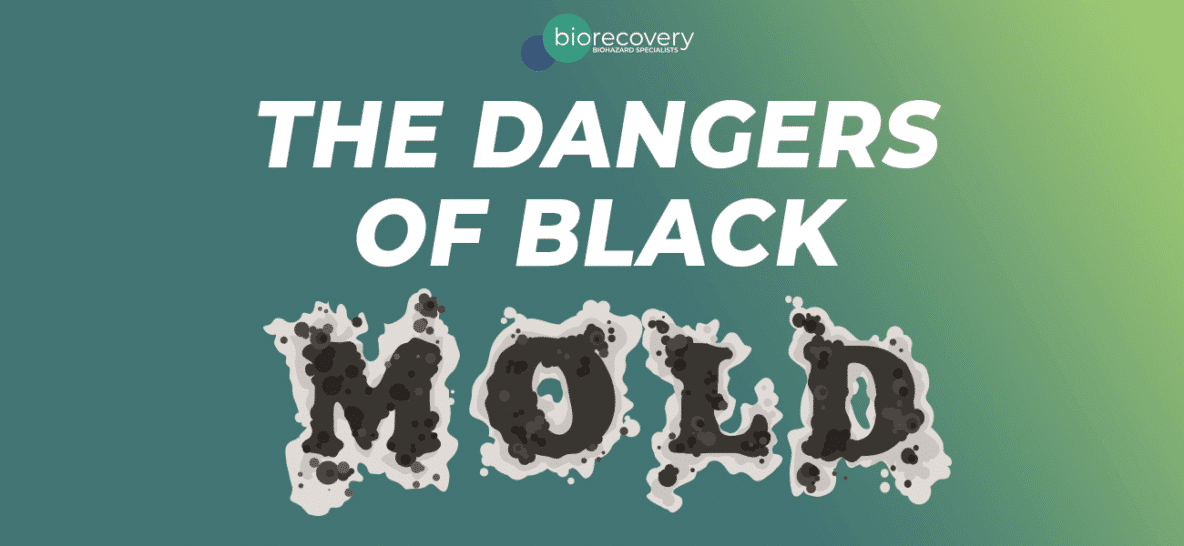When you think of home, you probably think of warmth, peace, love, and safety. But what many don’t realize is that their homes may in fact be a breeding ground for one of the all too common—and toxic molds: Stachybotrys. In this guide, we’ll explain everything you need to know about the dangers of black mold exposure.
What Is Black Mold?
Black mold, known in the scientific community as Stachybotrys chartarum, is a toxic fungus that feeds on materials commonly found in homes, including drywall, carpeting, and insulation. Though commonly referred to as black mold, in reality the color can range anywhere from black to dark green. It’s less common than other types of mold you may find in your home, but also more dangerous.
Once black mold gets into a home, it can spread quickly and cause health problems for everyone living there.
How Black Mold Get Into Your Home
Mold spores float in the air, and come into your home through doors, windows, and ventilation systems. They can even be carried in on your shoes or your pet’s fur. However, mold only begins to spread when it comes into contact with moisture. That’s why you’ll most often find mold growing in damp basements or along pipes.
Black mold grows especially well in homes because it feeds on porous materials like drywall and carpeting. However, like all forms of mold, it does require constant moisture to grow. Often, you’ll find black mold in your home after experiencing some sort of flooding or water damage.
Even without any type of water related incident, the dangers of black mold exposure can still be present, particularly in humid parts of a home like the bathroom or basement.
Locating & Identifying Black Mold
Often, you’ll see black mold growing in your home or smell it if an infestation gets bad. However, small infestations may be hard to locate, especially if they’re under sinks or in parts of your home that you don’t frequent. Many times, people mistake regular mold for black mold and do not take it as seriously as they should, until it’s already too late.
If you suspect you have a black mold problem, you’ll want to investigate any part of your home that may be moist. If you do need to identify the type of mold growing in your home, you would need to send a sample to an environmental lab, or call in an expert.
Prevention
The CDC’s stance is that it’s not entirely necessary to identify what kind of mold is growing in your home as long as you take the proper steps to remove mold from your home. Following this, steps need to be taken to prevent it from coming back as well.
The following are some easy and effective ways to minimize the risk of mold growing, or returning, to your home:
- Properly ventilate moist rooms/areas
- Immediately dry wet areas
- Monitor humidity
- Purchase a dehumidifier
- Hang wet clothing outside
Keep in mind that even if no longer see or smell mold after following these precautions, it still may be present.
Dangers of Black Mold Exposure
Black mold poses several health risks and dangers. Here are some of the primary dangers of black mold exposure:
Health Risks
- Respiratory Issues: Inhaling black mold spores can cause respiratory problems such as coughing, sneezing, and difficulty breathing. It can exacerbate asthma and other pre-existing respiratory conditions.
- Allergic Reactions: People exposed to black mold may experience allergic reactions, including runny nose, red eyes, skin rash, and throat irritation.
- Chronic Fatigue and Headaches: Long-term exposure to black mold can lead to chronic fatigue, persistent headaches, and a general feeling of malaise.
- Toxic Effects: Black mold produces mycotoxins, which can be toxic when inhaled or ingested. Prolonged exposure to mycotoxins can lead to more severe health problems, including neurological issues, immune system suppression, and even organ damage.
- Skin Irritation: Direct contact with black mold can cause skin irritation, rashes, and itching.
Environmental and Structural Risks
- Structural Damage: Black mold thrives in damp, humid environments and can grow on various building materials, including wood, drywall, and carpeting. Over time, it can cause significant structural damage, compromising the integrity of the affected areas.
- Decreased Property Value: The presence of black mold can significantly decrease the value of a property due to the potential health risks and the cost associated with remediation.
- Spreading Mold Spores: Black mold can release spores into the air, which can then spread to other areas of a building, exacerbating the problem and increasing the risk of health issues.
Black Mold Removal
Trace amounts of black mold can only sometimes be cleaned manually with a combination of household cleaners, bleach, and a little bit of elbow grease. However, large infestations of black mold absolutely need to be handled by professionals. Sometimes, this will necessitate briefly leaving your home while the mold is taken care of. To keep black mold from returning, you’ll need to keep your home dry and clean.
Bio Recovery offers professional nationwide mold removal services to all 50 states. If you have recently found an area indoors that is experiencing constant moisture, flooding, or is in direct contact with water, and you suspect that mold may be present, it is critical you hire certified mold remediation and environmental safety restoration technicians. Give us a call 24/7 at 1-888-752-5001 to speak with a representative today.
Conclusion
Black mold is a common household danger that can make members of your family sick. If you have excess moisture in your home, your home is older, or you’ve recently had flooding in any part of your home, you’ll want to ensure that you don’t have any black mold growing. Early intervention and prevention are the best ways to keep the dangers of black mold exposure from endangering your family.
